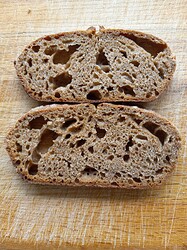I baked a straightforward loaf yesterday using my usual procedure, but the result was weird and unexpected. There was minimal rise or bloom, a dull crust, super-moist crumb with odd, big holes. Here are some particulars. 100% home-milled Glenn hard spring wheat (this is the first bake using a new batch of wheat berries), 75% hydration, bulk fermentation to a little over 50%, second rise in banneton for 1.5 hours, into clay baker at 450 degrees, 20 minutes covered, 15 uncovered, reached 210 degrees. It also spread an unusual amount when I tilted it out of the banneton. It’s a small loaf, only 300g flour. Is my starter funky? Something with the batch of grains? Any ideas? Thanks!
It looks under fermented to me.
Thanks, Abe, I’ll try letting the bulk fermentation go longer next time.
I think be bit more adventurous with the bulk and go easy on the final proof. You’ll get a more even crumb with less spread. Is it tasty? It looks quite ok, ive seen more under fermented loaves, and if it’s tasty that’s the main thing. If it spreads too much when turning out of the banneton tgen dont score. Because it is a small loaf do you think the banneton was too big?
Lately, I’ve been baking with weaker gluten grains, so I’ve been keeping the bulk shorter. The taste is fine and I’ll eat it, but there’s just something off on this loaf. The banneton is a bit on the large size for this small loaf but that’s the size that I always bake and I use that banneton, so that’s not it. I’ll let you know what happens when I readjust the proof times. Thanks!
Mystery solved. I baked a second loaf using your suggestions, Abe, for a longer bulk fermentation and shorter second proof, but the result was exactly the same weird loaf. So, I made a new starter and used it for the first time yesterday, using my usual routine and ended up with a normal loaf of bread. Funky starter!
So interesting! I would have totally said weak wheat and was going to recommend you try a slurry test with that wheat and another you know is strong – but then I kept reading the thread. Were there any discernably different characteristics (smell or texture) of your previous starter?
At least to me, there is no discernable difference in the starter, maybe a slightly stronger odor. And the bread dough itself seems perfectly normal up to the bulk fermentation. Even at the end of that, it’s pretty loose, but not abnormally so. It’s only after second proof and the actual bake that the problem is apparent.
I had this happen several years ago and was pretty sure that my starter had developed a thiol contamination. I discovered this through some posts by Debra Wink, a food chemist (at least I think that’s what her profession is) and baker on The Fresh Loaf website. This is a brief description of the problem by another poster on the site:
"Thiol is the chemical term for a family of chemicals with a certain chemical composition. It refers to the presence of sulfur in a compound where normally there would be oxygen. In general it makes the compound stinkier.
Sulfur is present in the proteins of wheat flour. It is the reactions of the sulfur in proteins that allow gluten to be formed. However, some bacteria process the sulfur out of the proteins and turn them into thiols. This leaves the proteins with no way to form gluten, or even destroys gluten that was already formed.
It is the errant bacteria that are the problem."
It is possible to restore an ailing starter to health by an aggressive feeding regimen, but I found it a lot easier, faster, and less wasteful to just create a new starter.
Melissa, my reply to your question regarding different characteristics wasn’t quite accurate. I just baked again and realized that the funky starter was much looser than the new starter, which was much stiffer, both at 100% hydration.
Gotcha. Sounds like maybe the thiol is damaging to gluten/protein.
